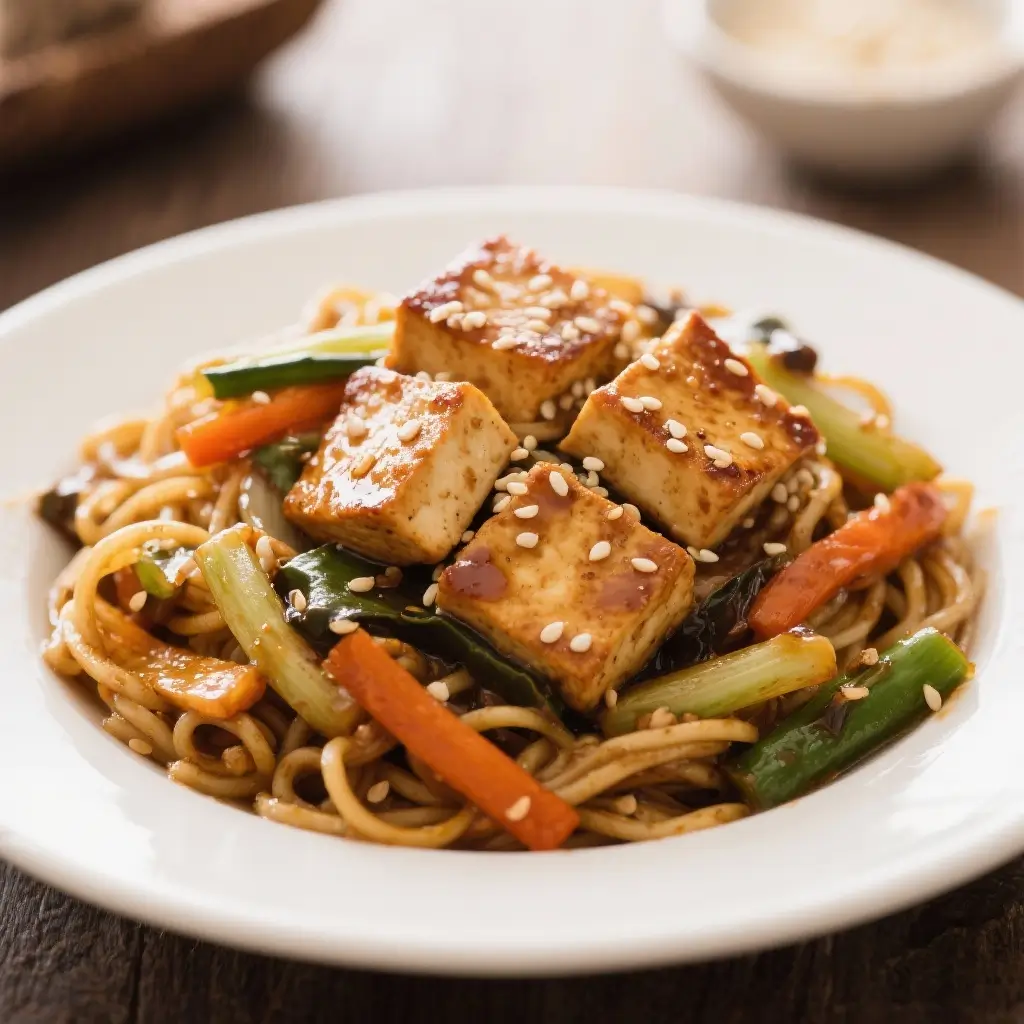Introduction
Welcome to a delightful fusion of East Asian culinary traditions and modern plant-based eating—Sesame Honey Baked Tofu with Stir-Fry Veg Noodles. This dish beautifully marries the rich umami of baked tofu with the fresh crunch of stir-fried vegetables, all wrapped in a savory-sweet sesame honey glaze, served over silky noodles for a satisfying meal that’s as nutritious as it is delicious. Whether you’re a seasoned vegan, a curious omnivore, or someone simply looking for a wholesome weeknight dinner option, this recipe delivers bold flavors, vibrant colors, and a comforting warmth that brings people together around the table. It’s not just food—it’s an experience: aromatic, colorful, and nourishing from the inside out.
The History
The roots of this dish lie in the long-standing traditions of Asian cuisine, where tofu has been a dietary staple for centuries, particularly in China, Japan, Korea, and Southeast Asia. Originating in China over 2,000 years ago, tofu was developed as a way to preserve soy milk and create a versatile protein source. Over time, different cultures adapted tofu into their regional cuisines—steamed, fried, fermented, or baked—with unique seasonings like soy sauce, ginger, garlic, and sesame. The concept of glazed baked tofu likely evolved from Japanese “abura-age” (fried tofu pockets) and Chinese “dry-fried tofu,” both of which use concentrated sauces to infuse flavor. Meanwhile, stir-fried vegetable noodles trace back to Chinese “chow mein” and Japanese “yakisoba,” where wheat or rice noodles are tossed with seasonal vegetables and savory sauces. The addition of honey in the glaze reflects a modern twist, blending traditional umami-rich ingredients with natural sweetness preferred in contemporary global palates. This recipe honors those cultural foundations while embracing modern health-conscious cooking techniques, creating a harmonious bridge between past and present.
Ingredients Breakdown
Every ingredient in Sesame Honey Baked Tofu with Stir-Fry Veg Noodles plays a vital role in building layers of flavor, texture, and nutrition:
- Firm or Extra-Firm Tofu: The star protein, chosen for its ability to hold shape during baking and absorb marinades deeply. Pressing removes excess water, allowing better browning and flavor penetration.
- Soy Sauce or Tamari: Provides saltiness and umami depth. Tamari is gluten-free and richer in flavor, ideal for those with sensitivities.
- Honey: Adds natural sweetness that caramelizes during baking, enhancing the glaze’s shine and complexity. For a vegan alternative, maple syrup works beautifully.
- Toasted Sesame Oil: Imparts a nutty, aromatic essence central to Asian cuisine. Used sparingly due to its strong flavor and low smoke point.
- Fresh Garlic & Ginger: Aromatic powerhouses that add warmth, pungency, and anti-inflammatory benefits.
- Rice Vinegar or Apple Cider Vinegar: Balances sweetness with acidity, brightening the overall flavor profile.
- Minced Green Onions: Contribute freshness and mild onion flavor, used both in the marinade and as garnish.
- Sesame Seeds: Add visual appeal and a subtle crunch, reinforcing the sesame theme.
- Noodles: Udon, soba, rice noodles, or even whole wheat spaghetti work well. They serve as the hearty base, absorbing sauce and complementing textures.
- Stir-Fry Vegetables: A rainbow mix such as bell peppers, broccoli, carrots, snap peas, mushrooms, baby bok choy, zucchini, or cabbage. These contribute fiber, vitamins, color, and crisp-tender texture.
- Neutral Cooking Oil: Like avocado or grapeseed oil, used for stir-frying without overpowering other flavors.
- Vegetable Broth or Water: Helps steam vegetables slightly during stir-frying, ensuring even cooking.
- Optional Add-Ins: Chili flakes, sriracha, hoisin sauce, lime juice, or crushed peanuts for heat, tang, or extra richness.
This thoughtful combination ensures a balanced dish that satisfies taste buds and nutritional needs alike.
Step-by-Step Recipe
- Press the Tofu: Remove tofu from packaging and drain liquid. Wrap in clean paper towels or a kitchen towel, place on a plate, and top with a heavy object (like a skillet or books). Press for 20–30 minutes to remove excess moisture. This step is crucial for achieving a firm, chewy texture and better absorption of the marinade.
- Prepare the Marinade: In a mixing bowl, whisk together ¼ cup soy sauce (or tamari), 3 tablespoons honey (or maple syrup), 2 tablespoons toasted sesame oil, 2 minced garlic cloves, 1 tablespoon grated fresh ginger, 1 tablespoon rice vinegar, 1 finely chopped green onion, and 1 teaspoon sesame seeds.
- Cut and Marinate Tofu: Slice pressed tofu into ¾-inch cubes or rectangles. Place in a shallow dish and pour marinade over tofu. Gently toss to coat. Let marinate for at least 30 minutes (or up to 2 hours in the refrigerator) for maximum flavor infusion.
- Bake the Tofu: Preheat oven to 400°F (200°C). Line a baking sheet with parchment paper or lightly grease it. Arrange tofu pieces in a single layer, reserving leftover marinade. Bake for 25–30 minutes, flipping halfway through, until golden brown and slightly crispy on the edges. During the last 5 minutes, brush tofu with reserved marinade to enhance glaze formation.
- Cook the Noodles: While tofu bakes, bring a large pot of salted water to a boil. Cook noodles according to package instructions until al dente. Drain, rinse under cold water to stop cooking, and toss with a small amount of oil to prevent sticking. Set aside.
- Stir-Fry the Vegetables: Heat 1–2 tablespoons neutral oil in a large wok or skillet over medium-high heat. Add harder vegetables first (carrots, broccoli) and stir-fry for 2–3 minutes. Add softer veggies (bell peppers, mushrooms, snap peas, bok choy) and continue cooking for another 3–4 minutes until vibrant and tender-crisp. Splash in 2–3 tablespoons of vegetable broth or water to create steam and aid in even cooking.
- Add Noodles and Season: Add cooked noodles to the wok. Pour in 2–3 tablespoons of soy sauce, 1 tablespoon sesame oil, and a drizzle of honey or rice vinegar if desired. Toss everything together using tongs or two spoons until evenly combined and heated through.
- Assemble the Dish: Divide stir-fry noodle mixture among serving bowls. Top generously with sesame honey baked tofu. Drizzle any remaining glaze from the baking pan over the top for extra flavor.
- Garnish and Serve: Sprinkle with sliced green onions, extra sesame seeds, crushed red pepper flakes, or chopped cilantro. Serve immediately while warm and fragrant.
Tips
- Press Thoroughly: The drier the tofu, the crispier it gets when baked. Consider using a tofu press for consistent results.
- Don’t Rush Marinating: Even 30 minutes makes a difference, but overnight marination yields deeply flavored tofu.
- Avoid Crowding the Pan: When baking tofu, ensure space between pieces so they roast rather than steam.
- High Heat for Stir-Fry: Use high heat to achieve that signature “wok hei” (breath of the wok)—a smoky aroma from quick searing.
- Prep Ahead: Chop vegetables and make the marinade ahead of time for faster weekday assembly.
- Reserve Marinade Safely: If using some marinade for brushing, set aside a portion before adding it to raw tofu to avoid cross-contamination.
- Customize Texture: For crispier tofu, air-fry at 375°F for 15–18 minutes instead of baking.
- Balance Flavors: Taste your stir-fry before serving. Adjust with more soy sauce (salt), honey (sweet), vinegar (tang), or chili (heat).
- Noodle Choice Matters: Soba adds earthiness, udon offers chewiness, and rice noodles keep it gluten-free.
- Leftovers? Store components separately in airtight containers for up to 4 days. Reheat gently in a skillet or microwave.
Variations and Customizations
This recipe is incredibly adaptable to suit various diets, preferences, and pantry availability:
- Vegan Version: Substitute honey with pure maple syrup, agave nectar, or brown rice syrup.
- Gluten-Free Option: Use tamari instead of soy sauce and choose gluten-free noodles like rice sticks, mung bean threads, or certified GF soba.
- Low-Sugar Adaptation: Reduce or omit honey and increase rice vinegar or citrus juice for brightness. Use monk fruit syrup for sweetness without sugar.
- Spicy Kick: Add sriracha, chili garlic sauce, gochujang, or a dash of Sichuan peppercorns to the marinade or stir-fry.
- Protein Boost: Add edamame, tempeh, seitan, or shredded chicken for extra protein.
- Different Glazes: Try teriyaki, peanut, miso-ginger, or orange-soy variations for new flavor profiles.
- Seasonal Veggies: Swap in asparagus and peas in spring; zucchini and tomatoes in summer; kale and sweet potatoes in fall; mushrooms and cabbage in winter.
- Noodle Alternatives: Spiralized zucchini, shirataki (konjac) noodles, or kelp noodles for low-carb options.
- Peanut Butter Twist: Stir 1–2 tablespoons of natural peanut butter into the marinade for a creamy, nutty depth.
- Meal Prep Friendly: Prepare tofu and sauce in bulk, store separately, and assemble fresh meals throughout the week.
Health Considerations and Nutritional Value
Sesame Honey Baked Tofu with Stir-Fry Veg Noodles is a nutritionally balanced meal offering a wide array of essential nutrients:
- Protein-Rich: Tofu provides about 10–15g of complete plant-based protein per serving, supporting muscle repair and satiety.
- Heart-Healthy Fats: Sesame oil contains monounsaturated and polyunsaturated fats, including sesamin and sesamolin—lignans linked to reduced cholesterol levels.
- Low in Saturated Fat: Naturally free from animal fats, this dish supports cardiovascular wellness when prepared with minimal added oils.
- Fiber-Packed: The variety of vegetables and whole grain noodles contribute significant dietary fiber, promoting digestive health and stable blood sugar.
- Vitamins & Minerals: Carrots offer beta-carotene (vitamin A), broccoli brings vitamin C and K, leafy greens supply iron and calcium, and sesame seeds add magnesium and zinc.
- Antioxidant Support: Garlic, ginger, and green onions contain compounds with anti-inflammatory and immune-boosting properties.
- Considerations: Soy remains a debated topic, but current research supports moderate consumption of minimally processed soy (like tofu) as safe and beneficial, even for hormone-sensitive conditions. Those with soy allergies should avoid tofu and explore alternatives like seitan or chickpeas. For diabetics or low-sugar diets, reduce honey content and monitor portion sizes. Using whole grain or legume-based noodles increases fiber and lowers glycemic impact.
- Estimated Per Serving (approximate): 450–550 calories, 20–25g protein, 60–70g carbohydrates, 15–20g fat (mostly unsaturated), 8–10g fiber, 900–1100mg sodium (can be reduced with low-sodium soy sauce).
This dish exemplifies how flavorful food can also support long-term health and wellness goals.
Ingredients
For the Sesame Honey Baked Tofu:
- 1 block (14–16 oz) extra-firm tofu, pressed and cubed
- ¼ cup low-sodium soy sauce or tamari
- 3 tbsp honey (or maple syrup for vegan)
- 2 tbsp toasted sesame oil
- 2 cloves garlic, minced
- 1 tbsp fresh ginger, grated
- 1 tbsp rice vinegar
- 2 green onions, finely chopped (plus more for garnish)
- 1 tsp sesame seeds
For the Stir-Fry Veg Noodles:
- 8 oz noodles (udon, soba, rice, or whole wheat)
- 2 tbsp neutral oil (avocado, grapeseed)
- 1 cup broccoli florets
- 1 medium carrot, julienned
- 1 bell pepper (red or yellow), sliced
- 1 cup snap peas or snow peas
- ½ cup mushrooms (shiitake or cremini), sliced
- 1 cup baby bok choy or spinach
- 2–3 tbsp vegetable broth or water
- 2 tbsp soy sauce or tamari
- 1 tbsp sesame oil
- 1 tsp honey or rice vinegar (optional)
Garnishes (optional):
- Sliced green onions
- Toasted sesame seeds
- Crushed peanuts or cashews
- Red pepper flakes
- Lime wedges
- Cilantro leaves
Directions
- Press the Tofu: Drain tofu and wrap in a clean towel. Place a weight on top and let sit for 20–30 minutes to extract excess water.
- Make the Marinade: In a bowl, combine soy sauce, honey, sesame oil, garlic, ginger, rice vinegar, green onions, and sesame seeds.
- Marinate Tofu: Cut tofu into cubes and place in a container. Pour marinade over tofu, gently mix, and refrigerate for at least 30 minutes (up to 2 hours).
- Bake Tofu: Preheat oven to 400°F. Line a baking sheet with parchment. Arrange tofu in single layer, pour excess marinade over top. Bake 25–30 minutes, flipping halfway and brushing with marinade near end for a sticky glaze.
- Cook Noodles: Boil noodles in salted water per package directions. Drain, rinse, and toss with a bit of oil. Set aside.
- Stir-Fry Vegetables: Heat oil in wok or large skillet. Add hard veggies first (broccoli, carrots), stir-fry 2–3 min. Add softer veggies (peppers, peas, mushrooms), cook 3–4 min more. Splash with broth to steam.
- Combine Noodles: Add noodles to veggies. Pour in soy sauce, sesame oil, and optional honey/vinegar. Toss well to coat and heat through.
- Serve: Divide noodle stir-fry into bowls. Top with baked tofu. Drizzle with extra glaze from pan.
- Garnish: Sprinkle with green onions, sesame seeds, chili flakes, or nuts. Serve hot with lime wedges on the side.
FAQ
Can I use silken tofu?
No—silken tofu is too soft and will fall apart. Stick with firm or extra-firm tofu for baking.
How do I store leftovers?
Keep tofu, noodles, and veggies separate in airtight containers in the fridge for up to 4 days. Reheat in a skillet for best texture.
Can I freeze this dish?
Tofu freezes well, but noodles may become mushy upon thawing. Freeze tofu and sauce separately; cook fresh noodles when ready to eat.
Is this recipe gluten-free?
Yes, if you use tamari and gluten-free noodles. Always check labels to confirm.
Can I grill the tofu instead?
Absolutely! Thread marinated tofu onto skewers and grill over medium heat for 3–4 minutes per side until charred and heated through.
What can I substitute for honey?
Maple syrup, agave, brown rice syrup, or date syrup all work as vegan-friendly sweeteners.
How can I make this spicier?
Add sriracha to the marinade, sprinkle chili oil on top, or mix in gochujang paste during stir-frying.
Can I use frozen vegetables?
Yes, but thaw and pat dry first to avoid excess moisture. Fresh veggies yield better texture and flavor.
Why did my tofu turn out soggy?
Insufficient pressing or overcrowding the baking sheet can lead to steaming instead of roasting. Press longer and bake in a single layer.
Is tofu healthy?
Yes—when consumed as part of a balanced diet, tofu is a nutritious source of protein, calcium, iron, and isoflavones, linked to various health benefits including heart and bone health.
Summary
Sesame Honey Baked Tofu with Stir-Fry Veg Noodles is a vibrant, nutrient-dense meal that combines crispy, glazed tofu with colorful vegetables and tender noodles in a symphony of sweet, savory, and umami flavors. Easy to customize and perfect for meal prep, this dish brings restaurant-quality taste to your home kitchen with wholesome, real ingredients.










